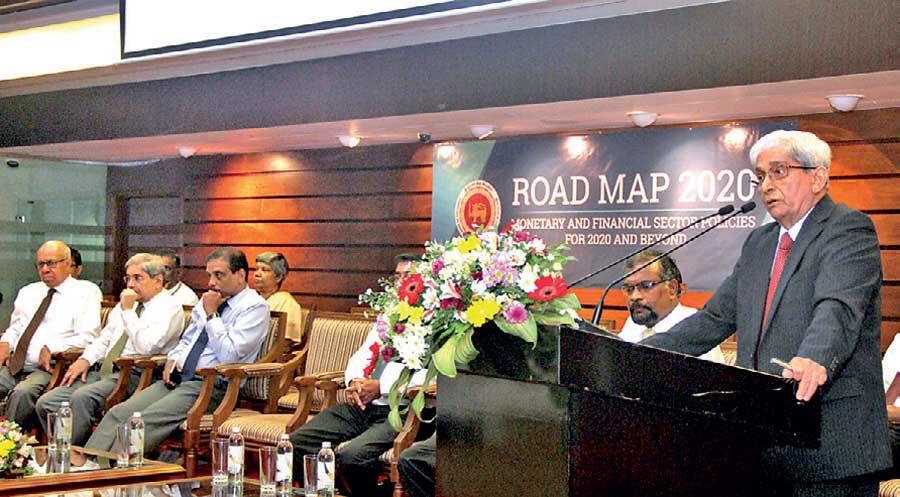Reply To:
Name - Reply Comment

Central Bank Governor Prof. W.D. Lakshman announcing the ‘Road Map 2020 – Monetary and Financial Sector Policies for 2020 and Beyond’ flanked by Treasury Secretary S.R. Attygalle, Monetary Board members and senior Central Bank staff
Pic by Pradeep Dilrukshana
By Nishel Fernando
The Central Bank (CB) plans to introduce a task force to introduce a cost-reflective benchmark interest rate for the banking sector, which reflects the actual cost of funds, in order to overcome the deficiencies in the current benchmark interest rates.
“The CB intends to set up a task force with the participation of the relevant stakeholders to introduce an appropriate cost-reflective benchmark interest rate for pricing loan products.
We believe that this measure will improve healthy competition among banks, while supporting efficient transmission of monetary policy measures,” CB Governor Prof. W.D. Lakshman said presenting the Road Map 2020, which outlines the financial and monetary sector policies for this year and beyond, in Colombo, yesterday.
Despite the CB’s accommodative monetary policy since mid-2018, he pointed out the market interest rates had remained high in both nominal and real terms during, compelling the CB to initiate the regulatory action of imposing caps on the deposit and lending interest rates of financial institutions.
The private sector credit growth slowed to 4.4 percent year-on-year (YoY) during the first 11 months of last year. The CB expects the private sector credit growth to pick up to around 12-13 percent by end-2020.
“This is sufficient to support a revival of economic activity. Driven by the expected growth in private sector credit, growth of broad money supply is likely to reach around 14 percent by end-2020. This is not expected to cause any excessive build up of demand pressures with adverse impacts on inflation,” Prof. Lakshman added.
In line with the envisaged low inflation environment, the CB plans to maintain reasonably low nominal interest rates over the medium-term to boost domestic economic activity.
Sri Lanka is targeting a 4-4.5 percent economic growth this year, driven by the recently introduced tax cuts and other relief measures as well as enhanced business confidence.
“While stability is important, a people-centric government cannot ignore its social and human development objectives, especially when Sri Lanka is ready for its economic takeoff.
We intend to pursue our efforts to find solutions to balance these conflicting objectives of public policy, without compromising economic and price stability and financial system stability,” Prof. Lakshman went on to say.
Speaking on the impact of low interest rates on fixed income earners, such as senior citizens, Prof. Lakshman urged the banking and other financial institutions to develop new financial products to suit the needs of such affected segments of the population.
He also requested the banking sector to re-evaluate their credit disbursement policies while noting that the traditional risk-averse mindset has deprived the country’s emerging entrepreneurs and new ventures of much-needed initial capital.
“Credit schemes that take into consideration the specific challenges faced by start-ups have failed to develop. The absence of dedicated development finance institutions is felt strongly, particularly at a time when the SMEs require support from the banking sector for survival during the phase of economic downturn as well as during the period of their takeoff,” he added.
The government is currently finalising a relief package, which is aimed at reviving Sri Lanka’s SMEs, particularly targeting non-performing advances.
“For those who seek relief under this package, suspension of legal action and rescheduling of loans along with some interest rate concessions have been proposed. The revival of businesses of such borrowers is expected to be facilitated through a grace period for capital repayments and a short-term working capital loan.
For borrowers in the performing category, a new facility with extended repayment periods, including a grace period for capital repayments under reasonable interest rates, is being considered,” Prof. Lakshman elaborated.
Prime Minister and Finance, Economy and Policy Development Minister Mahinda Rajapaksa is expected to present the final version of the relief package to the Cabinet of Ministers before the end of this month.
The CB is in the process of drafting a new Banking Act, which is set to be completed within this year and to be enacted by 2021. The proposed act will also contain provisions to extend regulations to banks, which are to be established in the reclaimed Colombo Port City land.
The key aspects of the proposed act include provisions to introduce a single type of banking licence for the licensed commercial banks (LCB) and licensed specialised banks (LSB) and adoption of proportionality in banking regulations commensurate with the bank’s size, its nature of operations, etc.
The proposed act would also allow subsidiarisation of banks incorporated outside Sri Lanka and allowing to ring-fence subsidiaries from adverse external shocks.
Further, the amalgamation of both offshore banking unit (OBU) and domestic banking unit (DBU) operations into a single banking business is also proposed.
The proposed act is expected to considerably strengthen consumer protection, deposit insurance and governance by improving resolution, enforcement and supervisory actions.
“As the regulator, we understand that crisis preparedness and resilience of banks need to be further strengthened. Accordingly, banks will be required to implement recovery plans in order to minimise the adverse impact on troubled banks and their possible spill over effects to the financial system,” Prof. Lakshman stressed.
In addition, the CB will also review the accounting standards and existing Banking Act directions with a view to strengthening prudential requirements on credit, market, liquidity, operational and other risks in line with the international regulatory standards and best practices.